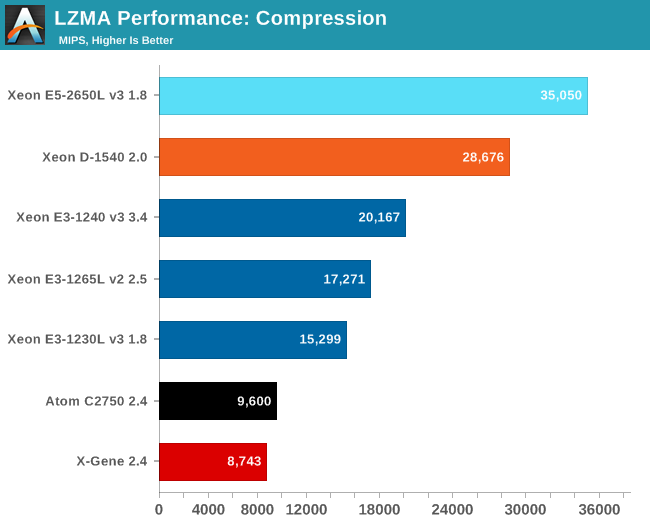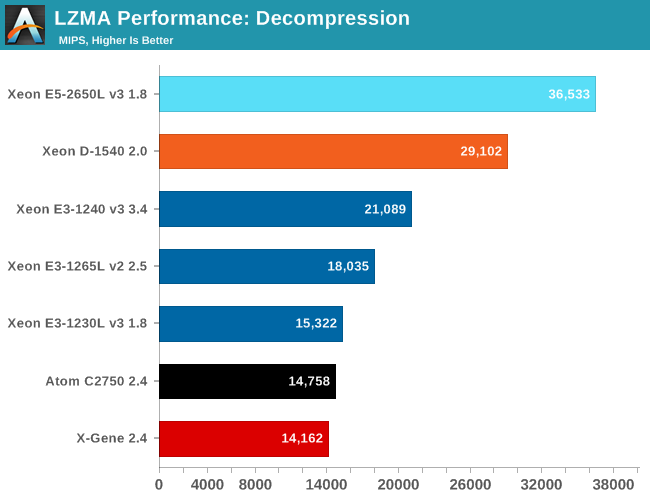The Intel Xeon D Review: Performance Per Watt Server SoC Champion?
by Johan De Gelas on June 23, 2015 8:35 AM EST- Posted in
- CPUs
- Intel
- Xeon-D
- Broadwell-DE
Multi-Threaded Integer Performance
Next we run the same workload in several active instances to see how well the different CPUs scale. The Xeon E5 and Xeon D should finally be able to show off their higher core counts.

The Xeon D scales well: performance is multiplied by 8. It is interesting to note that it delivers 82% of the raw integer processing power of the low power Xeon E5, which has 50% more cores and a 44% higher TDP (65W).
We did not test the Xeon E3-1265L v3 (45 W), but the 3.1 GHz chip will end up between the E3-1265L v2 and E3-1240 v3 (3.4 GHz), it will probably score something like 19000. The Xeon D delivers thus no less than 50% more raw processing power at the same TDP, while integrating more functionality. This should further drive down the total power a server uses. This really shows what an excellent improvement the Xeon D is if you can use the 16 threads.

The decompression benchmark tell us the same story as the compression test: the Xeon D delivers.










90 Comments
View All Comments
JohanAnandtech - Wednesday, June 24, 2015 - link
Hi Patrick, the base clock of our chip is 2 GHz, not 1.9 GHz as the one pre-production version that we got from Intel. I have to check the turboclocks though, but I do believe we have measured 2.6 GHz. I'll doublecheck.pjkenned - Wednesday, June 24, 2015 - link
Awesome! Our ES ones were 1.9GHz.Chrisrodinis1 - Tuesday, June 23, 2015 - link
For comparison, this server uses Xeon's. It is the HP Proliant BL460c G9 blade server: https://www.youtube.com/watch?v=0s_w8JVmvf0MrDiSante - Wednesday, June 24, 2015 - link
Why use only -O2 when compiling the benchmarks? I would imagine that in order to squeeze out every last bit of performance, all production software is compiled with all optimizations turned up to 11. I noticed that their github uses -O2 as an example - is it that TinyMemBenchmark just doesn't play nice with -O3?JohanAnandtech - Wednesday, June 24, 2015 - link
The standard makefile had no optimization whatsoever. If you want to measure latency, you do not want maximum performance but rather accuracy, so I played it safe and used -O2. I am not convinced that all production software is optimized with all optimization turned on.diediealldie - Wednesday, June 24, 2015 - link
Intel seems disARMing them... X-Gene 2 doesn't look so promising, as they'll have to fight mighty Skylake-based Xeons, not Broadwell ones.Thanks for great article again.
jfallen - Wednesday, June 24, 2015 - link
Thanks Johan for the great article. I'm a tech enthusiast, and will never buy or use one of these. But it makes great reading and I appreciate the time you take to research and write the article.Regards
Jordan
JohanAnandtech - Wednesday, June 24, 2015 - link
Happy to read this! :-)TomWomack - Wednesday, June 24, 2015 - link
This looks very much consistent with my experience; the disconcertingly high idle power (I looked at the board with a thermal camera; the hot chips were the gigabit PHY, the inductors for the power supply, and the AST2400 management chip), the surprisingly good memory performance, the fairly hot SoC (running sixteen threads of number-crunching I get a power draw of 83W at the plug) and the generally pretty good computation.I'm not entirely sure it was a better buy for my use case than a significantly cheaper 6-core Haswell E - Haswell E is not that hot, electricity not that expensive, and from my supplier the X10SDV-F board and memory were £929 whilst Scan get me an i7-5820K board, CPU and memory for £702. And four-channel DDR4 probably is usefully faster than two-channel for what I do.
I quite strongly don't believe in server mystique - the outbuilding is big enough that I run out of power before I run out of space for micro-ATX cases, and I am lucky enough to be doing calculations which are self-checking to the point that ECC is a waste of money.
JohanAnandtech - Wednesday, June 24, 2015 - link
Hi Tom, I believe we saw up to 90 Watt at the wall when running OpenFOAM (10 Gbit enabled). It is however less relevant for such a chip which is not meant to be a HPC chip as we have shown in the article. HPC really screams for an E5.